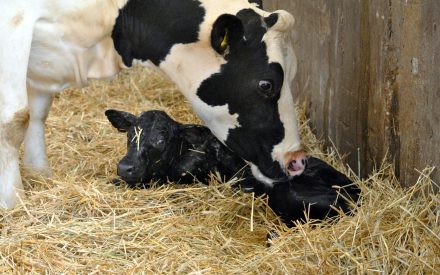Tips for Helping Cows and Calves Recover After Dystocia
Introduction
Listen to this article
Calf Activity and Weak Calf Syndrome
Stimulating the Calf
Use Caffeine or a Squeeze to Stimulate the Calf
What About Pain Medication?
Provide Colostrum and a Comfortable Environment
Give Extra Attention for Recovery

Introduction
While other articles discuss when and how to deliver calves, this one helps you assist the calf and cow in recovering from a difficult calving (dystocia). Providing post-calving care following dystocia makes a huge difference for the dam and her calf.
Listen to this article
Calf Activity and Weak Calf Syndrome
A newborn calf actively shakes its head, snorts, shivers, takes deep breaths and tries to stand. Weak Calf Syndrome occurs after a long labor (over 30 minutes for cows, 60 minutes for heifers) when carbon dioxide builds up in the calf. This leads to poor breathing, slow heart rates, and low internal body temperatures. Weak calves are slow to stand and nurse, often becoming depressed, and many of these calves scour and die within their first week.
Stimulating the Calf
Good mothering stimulates calves. However, exhausted dams may show little interest in their calf. Hydrating the dam reduces her exhaustion and boosts her interest. Offer the dam warm water to drink right after the birth and make it more interesting by mixing in electrolytes or milk replacer. Cows do not like to put their head into deep narrow buckets, so refill a short, shallow bucket until she is satisfied. Pen the dam and calf together until their bond is established.
Sometimes, you need to act as the mom: vigorously towel dry the calf, tickle its nostril with a firm piece of straw, pour cold water in its ear, and turn it from side to side. Salting the calf or sprinkling sweet feed over it will stimulate the dam to lick the calf.
Use Caffeine or a Squeeze to Stimulate the Calf
Orally giving caffeine ↗️ perks up dull calves within 15-30 minutes. You can use caffeinated energy drinks – just read the label and give the appropriate dose (100 – 200 mg of caffeine).1 Use a needleless syringe to gently deliver the dose to the back and left side of the calf’s mouth.
A Madigan Squeeze ↗️ helps a newborn calf anytime in its first two days. This technique involves squeezing the calf’s chest for 20 minutes by gently pulling on the trailing end of a soft rope that is looped three times around the calf. A rope halter works well for this. This mimics the squeeze through the birth canal, which helps the calf transition from a sleeplike state in the womb to being active outside.2 To view a picture of how to place the rope ↗️, visit the Iowa Beef Center.3
What About Pain Medication?
Consult your veterinarian to determine if pain medication for the cow or calf following dystocia is warranted. UW-Madison Division of Extension research review ↗️ of flunixin meglumine, meloxicam, and acetylsalicylic acid found only acetylsalicylic acid to have the potential for reducing inflammation and pain following dystocia in dairy cattle.4
Provide Colostrum and a Comfortable Environment
The calf must nurse several times in the first six hours to get colostrum. Hand milk the cow or feed good quality refrigerated or frozen colostrum or colostrum replacer (containing 100-150 IgG per dose) when the nursing quantity or quality is suspect. Milk-based colostrum replacers are preferred over serum-based ones. Mix and feed colostrum replacers exactly as their label indicates. If the calf can’t or won’t nurse, use a bottle or an esophageal tube.
Whenever possible, and especially after assisted births, soak the newborn’s navel in 7% iodine or another disinfectant recommended by your veterinarian. The navel is attached to the liver, and it will wick pathogens from the environment. Keep the calf’s environment clean and dry before the navel dries and falls off. Keep stressed calves following a difficult birth dry and warm by providing deep, fluffy bedding that covers their legs and belly when resting.
Give Extra Attention for Recovery
After dystocia, both cows and calves need hydration, time to bond, and a well-bedded area in which to recover. Talk with your veterinarian about providing caffeine or a Madagan Squeeze to the calf, or pain relief for the cow or calf following a difficult calving.
Author

Sandy Stuttgen
County Livestock Educator – Sandy is an associate professor with UW Division of Extension and serves as the agriculture educator for Taylor County. Her focus areas include cattle well-being and quality assurance programming, farm financial risk management, and farm succession.
References
- University of Minnesota Extension. (n.d.). Improving calf survival after birth. Retrieved November 12, 2024, from https://go.wisc.edu/1o31s2 ↗️
- Hanson, M. Weak calves may need a big squeeze. Bovine Veterinarian. Retrieved November 11, 2024, from https://go.wisc.edu/7t0k6b ↗️
- Iowa Beef Center, Iowa State University Extension and Outreach. (n.d.). Try the Madigan Squeeze. Retrieved November 11, 2024, from https://www.iowabeefcenter.org/news/MadiganSqueeze.html ↗️
- Schlesser, H. NSAID use around calving. UW-Madison Division of Extension. Retrieved November 25, 2024, from https://go.wisc.edu/641172 ↗️


 Feeding the Newborn Calf
Feeding the Newborn Calf Navel Care for Beef x Dairy Calves
Navel Care for Beef x Dairy Calves Planning Ahead for Newborn Calf Processing
Planning Ahead for Newborn Calf Processing Evaluating the calving season
Evaluating the calving season


